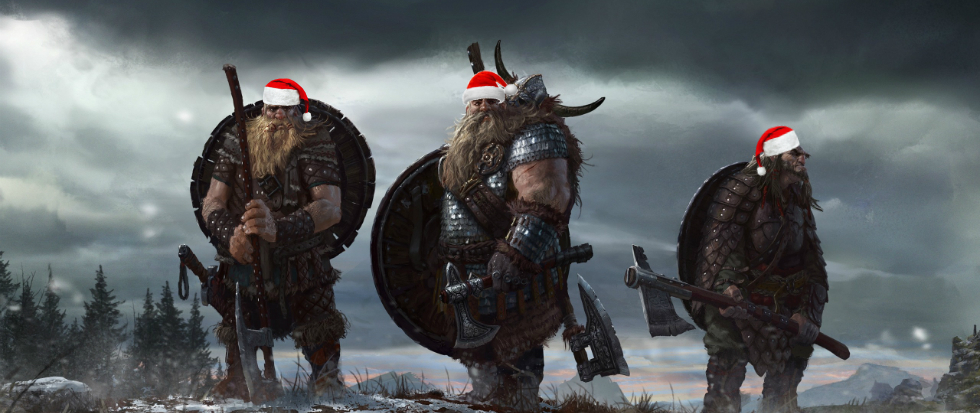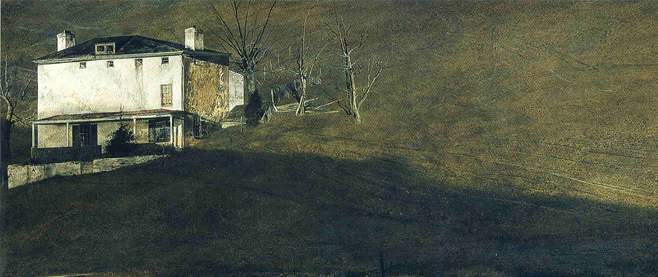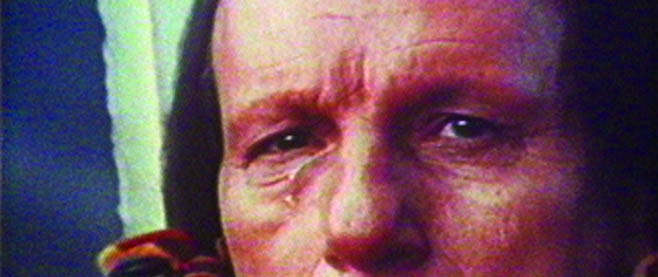
A Very Viking Christmas Interview
When, in 793, the Vikings first walked into the English monastery of Lindisfarne with gifts of swords, axes and shields, little did they know that their attempts to spread Yule-tide cheer would be badly misconstrued by the island’s monks. Nor did they realize that their reaction to the ungrateful monks’ act of running away – igniting everyone they could find, stealing all their stuff and getting drunk on fermented milk – would set the tone for 300 befuddled years of gift-giving and massacre.
It is only right that we still remember/imitate this tragic past with food, singing and violence every December 25th on Christmas Day. This year, the Financial Times and Sweden’s ambassador to the UK have tried to help by producing a Christmas carol that intermingles the words of ancient poems from England, Iceland and Scandinavia with modern music.
They commissioned Dr. Hannah Burrows, a lecturer at the Centre for Scandinavian Studies at the University of Aberdeen in Scotland, to compose lyrics from poems based on runes (the letters used in the northern Europe before the Latin alphabet), which were then set to music by the Swedish composer, Johan Hugosson.
The resulting Rune Carol is very pretty and treats medieval poetry and culture in a much more respectful way than my intro to this article did. You can hear a recording of the carol by the choir of Stockholms Musikgymnasium at the 17th-century Kungsholms Church in Stockholm right here:
Intrigued by this mix of the present and mysterious Scandinavian past, I asked Dr. Burrows for more information.
Unwinnable: I suppose the obvious first question is: what have you done and how did you do it?
Dr. Burrows: I created the concept and lyrics for a new Christmas carol, the ‘Rune Carol’, based on a selective mashup of a number of so-called rune poems from the medieval period.
Unwinnable: Why did you do it?
Dr. Burrows: I thought it was a really fascinating and exciting project – not something I have the opportunity to be involved in every day. Many people associate ‘Vikings’ with rape and pillage, but not so much poetry. True, some Old Norse poetry is about those things. But it’s also incredibly skillful and striking in its use of language, and I thought people could really be intrigued by seeing that side of Viking culture.
Unwinnable: What are the rune poems anyway? And what kind of world did they come from?
Dr. Burrows: The rune poems are acrostics where the name of each runic letter is the first word of and/or inspiration for the rest of the stanza. Examples survive in Old English, Old Icelandic, Old Norwegian and Old Swedish, all of which I tried to incorporate into the Rune Carol.
Unlike English letters, whose names are sounds that don’t mean anything else, runes had names like ‘ice’ and ‘hail’. The stanzas are like riddles or crossword clues, so ‘the coldest corn’ is ‘ice’, for example. This type of description was called a kenning and was fundamental to Old Norse poetry. For a long time, it remained really popular as a sort of secret language and/or intellectual puzzle.
People often associate runes with paganism, and now neo-paganism, because the runic alphabet was used in Scandinavia before the Latin alphabet was adopted with Christianity, and because they are associated with magic in some Old Norse stories. But runes continued to be used long after the conversion – they are easier to carve in wood or on stone, and they were used for the mundane purposes, like short messages passed between people.
The rune poems were all written in the Christian period, but the Scandinavian poems mention beings from Old Norse mythology, such as the god Týr and giants, because they have runic letters named after them. If that’s what the letters are called, that’s what they’re called, and Scandinavians didn’t try to hide that even a few hundred years into the Christian period. They don’t seem to be written with a religious agenda – they’re just part of a general interest in wordplay. The Old English rune poem, though, is explicitly Christian and praises God’s creation.
Unwinnable: How different is our perspective from the way the poems’ audiences saw the world?
Dr. Burrows: The rune poems weren’t written for Christmas so the main concessions I made were to try and select descriptions that a modern audience would recognize as appropriate. Winter is generally very bleak in the sources, rather than the more romanticized view we get now at this time of year. It was appropriate enough to keep in some of those harsher descriptions, but I tempered that with a movement through the Rune Carol towards light and hope.
I also avoided things that might be overly weird for people who aren’t familiar with Old Norse poetry – and one of the weirder lines I did include, ‘hail’ as ‘sickness of snakes’, didn’t end up being used by the composer.
Unwinnable: It seems like making a Christmas carol from the rune poems was more than translation – more like transformation. What worries did you have about that?
Dr. Burrows: It’s more usual for me to be translating poetry for scholarly projects like Skaldic Poetry of the Scandinavian Middle Ages, which means trying to be strictly accurate about the meaning of each word. It felt a bit strange to be creating something that wasn’t a direct representation of something that actually existed, and I knew I wouldn’t be able to add all the footnotes that would have eased my conscience.
The FT made it clear it was a ‘creative adaptation’, though, rather than a translation, and I consoled myself with the thought that medieval authors adapted things to suit their purposes all the time. There’s already so much variety between the rune poems and so many other similar texts that it’s impossible to think of any of these texts as unchangeable entities that are somehow sacred and untouchable. In an oral society, lines and concepts were borrowed between poems all the time, so I like to think there’s an authenticity in my method there if nothing else.
I was also concerned to create a Rune Carol that would work musically, but I essentially borrowed the rhythm of the Icelandic rune poem and that took care of that.
It certainly made me ask slightly different questions of the material than I would have otherwise, and hearing the composer’s interpretation made me think in a different way again. I think it makes you think about the original performances of the material, not just about the words on a page. And hopefully it intrigues people who wouldn’t ordinarily have sought out such material.
Unwinnable: The poetry still has some of the feel of the original rune poems. When you were adapting, were you trying to recapture some essence of the original poetry or of the world they came from? How did you avoid tweeness?
Dr. Burrows: I definitely wanted to capture as many features of Old Norse poetry as I could, since I was adapting so much else. I took the form of the Icelandic rune poem as a base and tried to keep as much alliteration and other sound effects like internal rhyme as possible. Old Norse poetry is also syllable- and stress-counting, and that was useful for getting a sense of rhythm that I thought would be singable.
I’m glad you think I did avoid tweeness! The medieval poets can be thanked for that. Though I had to add the odd word here, pretty much everything in the Rune Carol comes from the originals. They have a beautiful simplicity which is at the same time thought-provoking. And though I mixed and matched pretty freely between the different poems, I didn’t mix up descriptions of one thing with descriptions of another, so everything that goes with a particular rune name is connected to that rune name in at least one of the medieval poems.
Unwinnable: Your Rune Carol is now part of the FT brand. What do you think about that use of historical culture in modern brand development and are there any parallels in the original context of the rune poems?
Dr. Burrows: These are SUCH interesting questions. Corporate culture and academia, especially the arts and humanities, are in some ways seen as opposed – there’s that impression that corporate culture is a bit soul-destroying and uniform, or at least that the two operate in completely different spheres. But the Academy hasn’t always had the best reputation either, with the impression people have that it’s disconnected from the real world. That’s something universities are really trying to address at the moment.
I didn’t really think in those terms at all when creating the carol. I saw the FT as a terrific and wide-reaching platform from which to showcase Old Norse poetry, and I was given links to the previous carols they’ve commissioned, so I knew broadly what they were expecting. But I definitely wasn’t given any instructions or goals to adhere to that would fit in with their brand image. Perhaps that’s due to the extra degree of separation I had. I was dealing with the Swedish Embassy, in particular with someone I’d met and whom I knew was really enthusiastic about Old Norse poetry, so I felt fairly free to do what I thought appropriate.
On the whole I think it’s great for everyone – companies, universities, the wider public – if these kinds of collaborations can take place. Previously the FT carols have taken lyrics from works by the likes of Shakespeare and Henry Wadsworth Longfellow, which are more familiar and uncontroversial. By not only going for something which was a new creation but was based on a much less mainstream culture, they really took a risk, and I appreciate that and find it exciting.
This doesn’t apply so much to the rune poems, but lots of Old Norse poetry was really ALL ABOUT branding. Kings and other rulers/leaders/wannabes took on poets to compose poetry, which was seen as a durable way of commemorating their greatness and for some kings that has proved to be the case.
Unwinnable: Cool. Thanks for your time! And Happy Rune Carol Christmas, obviously.
Dr. Burrow’s lyrics and the musical score can be found at ft.com/carol2015.
Full disclosure: I work at the same research center as Hannah, so it’s understandable that her work interests me. In fact, it seems weird to call her Dr. Burrows, but I like the classy edge that it gives the article.
Even fuller disclosure: the Vikings probably weren’t bringing Christmas presents when they raided Lindisfarne. It probably happened in June, so all the presents must have been for a different reason.





